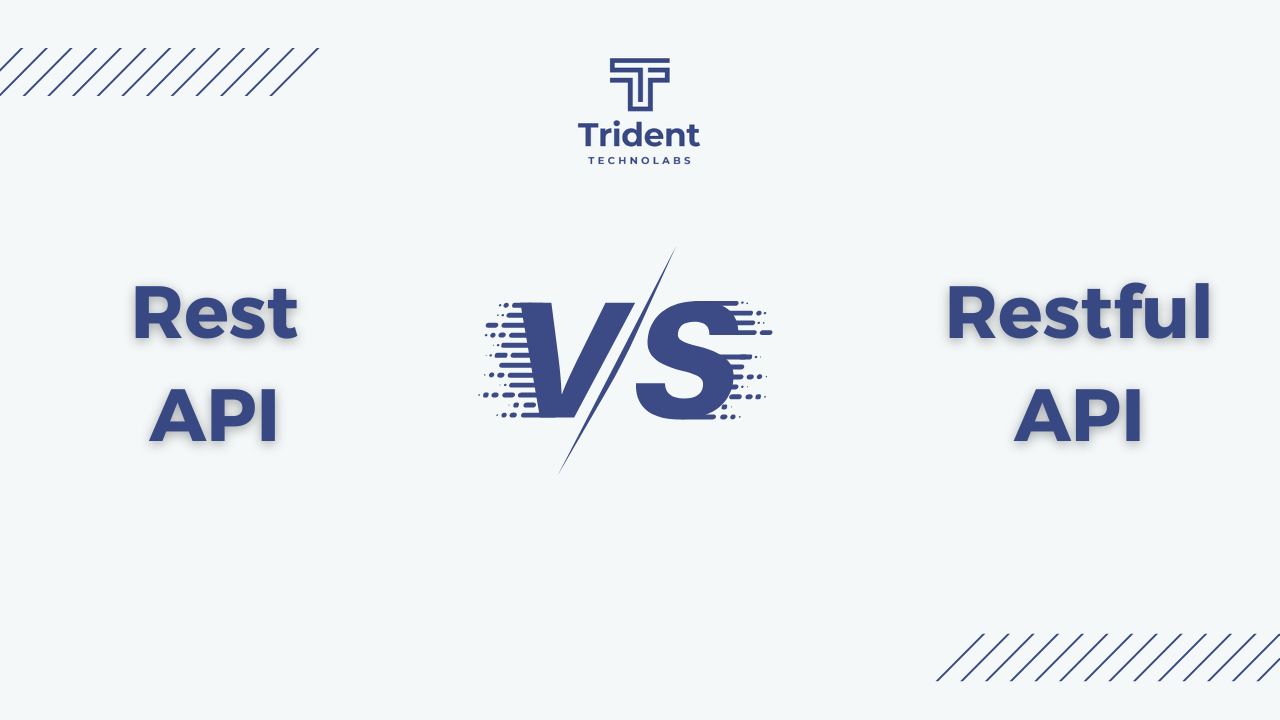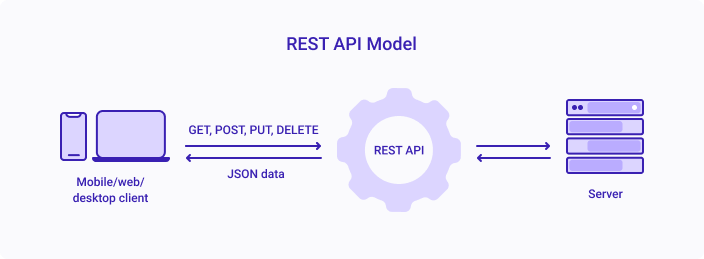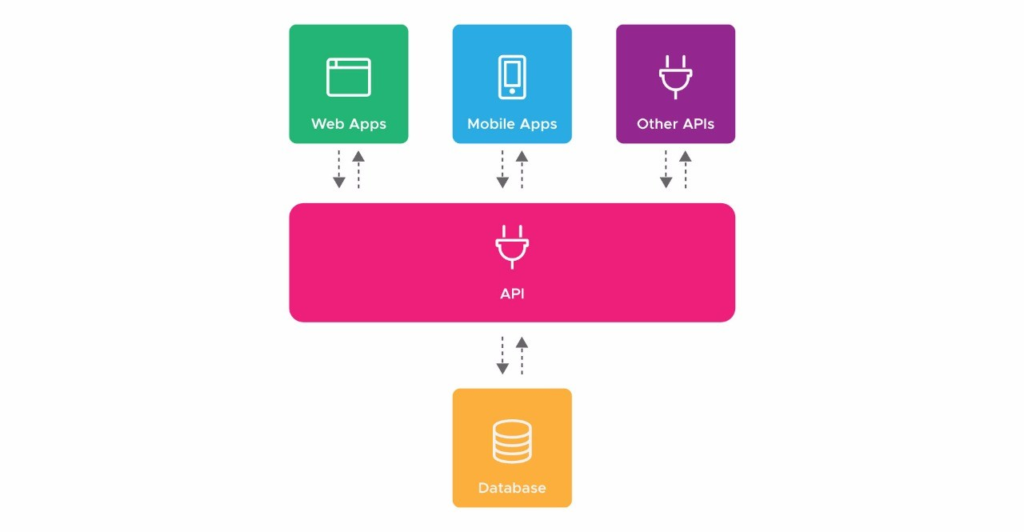
REST API vs RESTful API : Which One Leads in Web App Development?
This is the age of integration where exchanging data between two or more systems has become more important than ever before.
For example, Uber needs location access from Google Maps and payment access from PayPal. And what acts as a middleman between two applications and helps them communicate with each other is an API or Application Program Interface.
Although you have multiple approaches to creating APIs, there are two particular methods you should know to facilitate software interaction in your project – REST APIs and RESTful APIs.
While the difference between them may not seem obvious at first, it is not just a geeky question from Stack Overflow either. Chances are you will find someone raising their voice about it while you are in a session with your development team and discussing software architecture patterns for the product.
In short, REST (Representational State Transfer) is an architectural style, whereas RESTful refers to the web services that implement such a style.
So, can you use these terms interchangeably? To a certain degree, yes, but that does not mean you should. The right answer is not really as simple as “REST is a noun and RESTful is an adjective.”
This blog aims to elaborate on the subtle difference between REST vs RESTful APIs so that you do not mess up with what they are, how they work, and how you can utilize them in your development project.
Tell Me About a REST API

Suppose you are trying to find YouTube videos about Star Wars. You open the app, search “Star Wars,” hit enter, and see a list of related videos.
REST APIs work in a similar way that helps you get results for the service you have requested while searching for something on the internet. In 2000, Roy Fielding introduced the concept of REST API specifications, which has later become a dominant practice in modern software engineering.
API is basically a set of rules that developers create on the server-side to enable programs to communicate with each other. And REST determines how the API will look and work and what architectural pattern developers will follow to build it.
Some of the key principles REST APIs follow are:
- Layered system – REST elements cannot see beyond their appointed layer. This results in improved scalability and easier addition of proxies and load balancers.
- Uniform interface – The most important feature of the REST architectural pattern is its emphasis on the uniformity of interfaces between all the components.
- Cacheability – REST servers have to identify their responses as cacheable or not so that disposing of non–cacheable information and caching required information is possible for performance improvement.
- Statelessness – In REST applications, clients maintain the application state, but servers do not manage any client state. The service requests comprise all the information needed for processing.
What About a RESTful API?

Now RESTful APIs adopt and follow the REST architecture constraints (a set of protocols an API must adhere to), enabling them to be scalable, faster, and support all types of data. An API of this kind access data by using HTTP requests and is the most common type of API used in web development stacks.
Some of the primary components RESTful APIs consist of are:
- Headers – With the help of HTTP headers, RESTful APIs manage information, such as connection types, proxies, and metadata, for request messages as well as their valid responses.
- Data – Data is the body that contains further information on the client-requested resource. When a client determines the content type in the header, the body contains the actual content.
- Method – These APIS manipulate data by using certain HTTP methods like DELETE, POST, or GET to help servers work properly.
- Endpoints – These are URLs that define the data location on the server. Endpoints are basically the resources we try to access via an API.
RESTful web services or APIs come with a range of benefits. For instance, they use less bandwidth, support every kind of data format, have an easy learning curve, and developers do not need to build it from scratch. These APIs are very popular in the SaaS application development field and most suitable for both public and private use.
The Subtle, Yet Crucial, Difference Between REST vs RESTful APIs
Now that you are aware of what REST and RESTful APIs are and how they work, let us understand how they are different from each other in terms of given parameters:
1. REST vs RESTful API: Architecture
The architecture of a REST app has a layer system and a client-side with uniform UI, whereas a RESTful app has the same architecture with some added features.
In addition, a REST server works with a client-server to handle user interactions, and the REST framework manages app performance through an independent system. It identifies any scope of improvement or update in individual tracks.
2. REST vs RESTful API: Consistent UI
As mentioned before, uniform or consistent user interface is one of the key components of REST applications. This is what mostly differentiates REST architectures from other network-based patterns. Such APIs successfully maintain an unchanging interface across different devices.
And in terms of handling data as resources, both RESTful vs REST systems do it with a distinctive and unique namespace.
3. REST vs RESTful API: Caching Capacity
REST APIs suggest data as cacheable/non-cacheable to replace the non-cacheable data, where RESTful apps allow clients to use cacheable data anywhere, anytime.
You can easily improve the performance and functionality of REST systems as the infrastructure and clients are able to store the data. When no one uses the stored data, the system can displace the non-cacheable information.
On the other hand, building a RESTful API enables you to access cacheable data and unchanging states whenever and however you need. It also enables you to follow the latest enterprise web development trends and customize the system as per your requirements.
4. REST vs RESTful API: Stability
REST apps keep up with no client state, and the client deals with each application phase, while RESTful servers just conceal the execution.
Any server request contains all the required information for processing. Assuming that there are any changes in the state of the RESTful APIs, the client answers to the framework for storage capacity and gets the specific contrasting information from REST with system infrastructure. It uses distributed objects to prevent the data from other elements.
In REST frameworks, the client and server trade information about the state and information, whereas RESTful web services do not conceal any data.
5. REST vs RESTful API: Multi-Layered Architecture
Between REST vs RESTful, REST devices cannot view beyond the assigned layers, whereas RESTful apps facilitate data flow between multiple layers.
This is why you need to use proxies or load balancers to improve the security measures and performance of REST systems. Contrastingly, a RESTful API merges the stateless limits to create a system with secure boundaries. Additionally, the distinction between those boundaries is very clear and definitive, and the data flows from one layer to another depending on clients’ needs. Clients have the power to display the data or manipulate it.
RESTful API vs REST API at a Glance
It’s time for a brief rundown and go through some other differentiating factors between RESTful vs REST API. Have a look:
- In REST applications, the URL works based on the request and response, whereas RESTful APIs totally rely on REST apps.
- REST systems have strong protocols and pre-configured architecture layers as security measures. On the contrary, RESTful apps have multi-layered transport protocols that make them comparatively less secure.
- The data format of a REST API is based on HTTP, whereas the data format of a simple RESTful API relies on Text, HTTP, and JSON.
- In terms of bandwidth, RESTful apps consume less bandwidth, and REST systems only consume minimal bandwidth.
- REST APIs are highly user-friendly and adaptable for a range of software development methodologies. Alternatively. RESTful services are way too flexible as to RESTless APIs.
The Far-Fledged Dynamics of REST API vs RESTful API
If there’s one thing that has become completely clear over the course of the last few years, it’s how dependent we have become on technology and innovation. We’ve encountered everything, from organizations progressing to remote working environments to the wave of rapid occasions affecting supply chains. Tech has assisted us with traversing everything, and Microservices and APIs give the framework that has made a large number of these movements conceivable.
In this regard, the REST architectural pattern has merged to be the only game in town at this time with the following benchmarks as mentioned in the State of API report:
- Use it and love it – 49%
- Use it – 44%
- Aware of but don’t use it – 4%
- Never heard of it – 2%
These insights should help you with some ideas on how you can make the most of REST vs RESTful APIs, where to invest your project resources, and what opportunity you can afford!
REST and RESTful API Difference: Solve Your Dilemma with Trident Technolabs. In the end, we can say that the difference between REST and RESTful does not really matter. Ultimately, how efficiently your architecture style aligns with your business and project goals is the most important deal here, not how well you can comply with a hit-or-miss standard. So, should you leverage the power of REST and RESTful APIs? Absolutely yes. For enterprises, irrespective of their size, deploying these technologies and integrating your applications with recognized programs empower you to interact with global businesses and cement your venture as reliable and credible. Is it not the time to make the most out of it? Reach out to our experts to discover more about these useful services and how you can comfortably perform the steps outlined in this read!





Leave a comment: